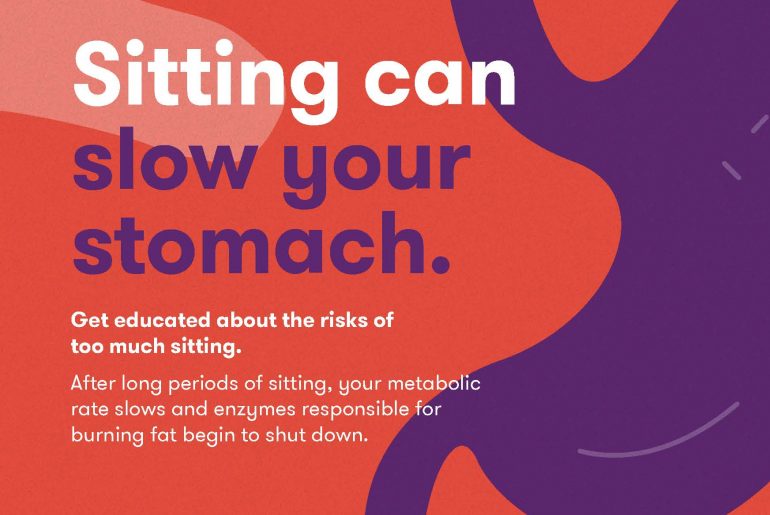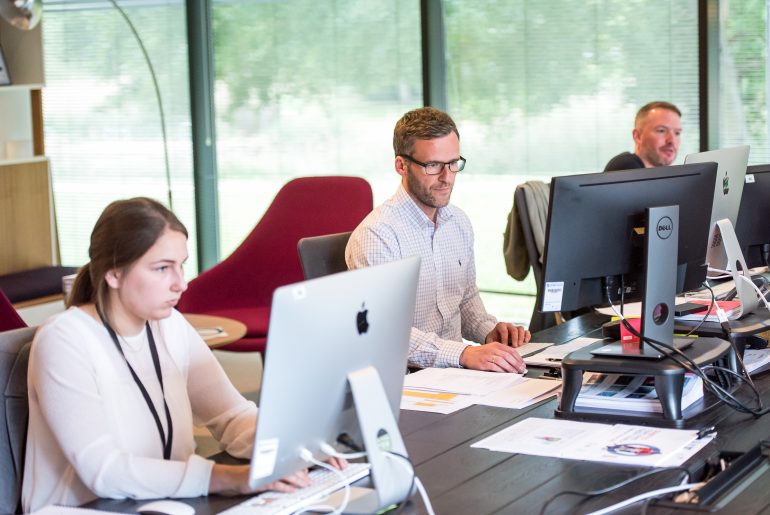A personal story of sitting less and moving more by Connor Soles Before coming to Queensland to study in the Doctor of Medicine program I considered myself an active person. I commuted by bicycle to my then-job as a medical scribe where I followed physicians into consultations and composed hospital charts on a mobile workstation. The hustle and bustle of the Emergency Department meant that I would cherish the rare moments that I would roll to a stop near the physicians alcove, cleverly positioned adjacent to the insta-coffee machine, and slump into a swivel chair to polish my notes. I had never experienced what it was like to be chained to a workstation seated, unmoving, for long periods of time before beginning medical school, and I’d never had to learn how not to be. In my newly (half) furnished apartment (in Brisbane) I found that I could not escape our IKEA table turned desk, which was the only assembled piece of furniture aside from the couch. As a medical student studying now consumed and overwhelmed the majority of my waking hours, that and maintaining my relationship with my fiance who had accompanied me to Australia, left little time for my…
How You Can Sit Less and Move More When Working From Home
These days many workplaces have flexible working arrangements that enable staff to work from home (telecommute) one or more days a week. Telecommuting can reduce business expenses significantly and increase employee satisfaction and productivity. The advantages for staff working from home are many: You can wear comfy clothes A custom environment with as little or as much noise as you like It’s easier to make calls No office distractions Zero commuting Save money However, even when you are working from home, the majority of your time is likely to still be spent sitting at a desk or table. Our main reaction to a busy workload is to sit for as long as possible until the task is done. Before you know it, hours have gone by and you have not moved from your chair. Excessive sitting can affect your metabolism, including your blood sugars and fats, putting you at increased risk of diabetes and cardiovascular disease. Remaining in one posture for hours at a time can also affect the muscles in your back, neck, hip flexors, hamstrings and calves. Here are some tips to sitting less and moving more on your telecommuting days: Take regular breaks during your day to…
Surprising Data on the Cost of Sitting in the UK
Get Britain Standing’s page on costs of prolonged sitting for the employer has some surprising facts. The page breaks these down into three categories absenteeism, presenteeism, and costs to engagement and wellbeing. What is presenteeism you may ask? I’m sure we’ve all felt it before. I can recall showing up to work feeling “out of it.” Even when employees are present the tolls of prolonged sitting can impact the quality and quantity of work. Absenteeism is easier to quantify. Average sized employers (250 persons) loose an estimated 4800 GBP/week due to absences with all businesses forgoing a total of 15 billion GBP annually. Of this 1/3rd (5 billion GBP) is due to low back pain, an ailment directly related to sedentary behaviour. The financial boon of wellness programs in part accounts for their eager adoption overseas and here in Australia. Trades Union Congress (TUC) of Britain estimates that wellness programs can reduce absences by as much as 42%. Reorienting the workplace to support dynamic movement with sit-stand desks, walking meetings, and active breaks may seem daunting to employers but resources like Get Britain Standing and Australia’s own BeUpstanding have the tools to get your workplace started. This article was written…
Get the Commonwealth Standing
I was perusing the British movement blog Get Britain Standing when I came across their solutions page. Get Britain Standing is a resource for employers much like Australia’s BeUpstanding, which focuses on a healthier Britain by reducing the prolonged hours of sitting that accompany many jobs. Their upcoming nationwide event On Your Feet Britain is set for April 24th 2020 with a reported ~2 million office workers participating. Get Britain Standing accounts that Briton’s working hours contribute ~70% of the daily sedentary health burden. Dr. Stuart Biddle, a professor of Active Living and Public Health is quoted on their website acknowledging the growing body of evidence that to be healthy we must move dynamically throughout the day. Which leads me to what excited me about their Solutions page: the balance board section! The benefit being, as long as you don’t fall off, strengthening your balance and your core muscles at your standing desk. They come in a variety of styles from the simple sea-saw, the log roll, and even the expert level half dome or as I like to call it the danger dome! (see image) Maybe don’t tell HR about the nickname when you bring one to the office.…
The Goldilocks Zone for Movement
It takes no large leap of the imagination to see that the human body was not shaped for a life in an office chair, car, or couch. Our ancestors were habitual movers constantly engaging in mild to moderate exercise. That is all well and good you may say, but as westerners with lives dominated by sedentary behaviour exercise must be supplemented back into our lives. A recent meta-analysis on movement lays out guidelines for a “Goldilocks” zone of exercise for maximal health benefits. This approach bestows maximal benefit with as little as 50 minutes per week (equivalent to running just 5-6 miles). The study emphasised diminishing returns from daily high aerobic exercise in favour of more frequent low to moderate exercise such as walking or yoga. The study references of cohort of daily endurance athletes over the age of 45 who were measured to have an increased risk for cardiovascular events as compared to those with a more moderate activity profile. Key Take Aways: Sitting should be limited to 30 minutes at a time punctuated by a “brisk” 5 minute walk Use a sit-standing desk when possible to alternate postures regularly There is no upper limit for mild to moderate…
Sitting can slow your stomach – Part 1
Have you ever experienced stomach pains, discomfort, or indigestion after sitting too long at your desk? While exercise has long been anecdotally thought to influence digestion, more recent research has been exploring the impact of physical inactivity on digestion. This post will explore some ways exercise and inactivity influences your gut, as well as the implications for your health. But first, what does it mean to say that sitting “slows your stomach?” One way to consider it would be gastric emptying, or the movement of stomach contents into the small intestine (how quickly food leaves the stomach). Another possibility is gastrointestinal transit time, which is the time it takes something you eat to move from your mouth through your entire gastrointestinal tract. Both these definitions have been linked to physical activity and inactivity, as have health outcomes such as constipation and colorectal cancer. How physical inactivity slows your stomach: When you aren’t moving, your gut isn’t moving much either. An extreme example can be seen in people who are confined to bed or held immobile. Hospital inpatients are another population at risk of prolonged physical inactivity, and increased rates of constipation are seen in this population. However it can be…
Six Strategies For Sitting Less
Six Strategies for Sitting Less Scratching your head on how your team can BeUpstanding? A recent study by Hadgraft and colleagues and published in the journal BMC Public Health, explored office workers attitudes around reducing workplace sitting. They also sought out workers opinions on a variety of strategies aimed at reducing occupational sitting, which were commonly identified from previous workplace interventions, and their perceived barriers to achieving this in the workplace. A number of strategies were viewed as acceptable and likely to be adopted by workers with some of the strategies addressing multiple influences on sitting and catering to a range of different jobs and preferences. Why not give some of the strategies a try in your workplace! Make use of standing meeting. Sick of sitting through endless meetings? Look to change it up by changing your posture. A standing meeting can be used for a quick check in with the team, while putting stand and stretch breaks into the agenda can help your team reset and refocus. Why not step it up by having a walking meeting for those one-on-one catch ups! Communicating face-to-face. Whenever there’s a short message to be conveyed to a co-worker, employees can tell the…
Standing Up To Sedentary Working
The following article was written by Sophie O’Connell and published in Occupational Health and Wellbeing on the 7th June 2019. The modern world and the constant pursuit of technological growth have almost eliminated the need for movement in our daily lives. While commuting we sit in our cars or on the bus; at work we sit at our computers or in meetings; during our leisure time we sit watching TV, playing computer games or socialising with friends. Because of technology advancements we do not even need to leave the comfort of our own homes to socialise, stay in touch with friends and family, to shop, to work or even be entertained on a screen. This means that, on average, Brits spend around 9.5 hours a day spent sitting. Typically, the amount of time spent sedentary each day increases with age. In working-age adults much of this sitting is done at work. Evidence shows that office-based workers spend around 75% of their working day sitting, with a third of sitting time being done for a prolonged period. Many of us are guilty of spending time sitting for extended periods due to work, travel or various social commitments. But with the growing…
Direct Healthcare Costs Of Sedentary Behaviour In The UK
The following press release originally appeared on the BMJ Newsroom and was published on March 23rd 2019. Spending large amounts of time sitting or lounging around during the day is linked to around 70,000 deaths per year in the UK and the NHS spends in excess of £0.7bn per year treating the health consequences, suggests research from Queen’s University Belfast and Ulster University published online in the Journal of Epidemiology & Community Health. A large proportion of the UK population have sedentary jobs and leisure activities, and official physical activity recommendations regarding sedentary behaviour are vague. Previous studies have shown that spending large parts of the day sitting down increases the risk of cardiovascular disease, type 2 diabetes, cancer and death and is a burden on health services. But no estimate of the financial impact that sedentary behaviour has on the NHS has been calculated, so the authors set out to do just that. Figures calculated by other researchers on the impact sedentary behaviour has on the relative risks of five specific health conditions (type 2 diabetes, cardiovascular disease, colon cancer, endometrial cancer and lung cancer) and deaths from all causes were combined with figures on the percentage of adults…
Americans Are Sitting at Record Rates. Here’s Why That’s So Dangerous
The following article was written by Alice Park and was originally published by Time on April 23, 2019. Every day, we modern humans stay comfortably seated on our behinds for hours at a time: binge watching shows on Netflix, pecking away on keyboards at work, scrolling through social media feeds. But do people really sit more than they used to? That’s what Yin Cao and an international group of colleagues wanted to find out in their latest study published in JAMA. While studies on sitting behavior in specific groups of people — such as children or working adults with desk jobs — have recorded how sedentary people are, there is little data on how drastically sitting habits have changed over time. “We don’t know how these patterns have or have not changed in the past 15 years,” says Cao, as assistant professor in public health sciences at the Washington University School of Medicine. The researchers used data collected from 2001 to 2016 by the National Health and Nutrition Examination Survey (NHANES), which asked a representative sample of Americans ages five and older how many hours they spent watching TV or videos daily in the past month, and how many hours they spent…










